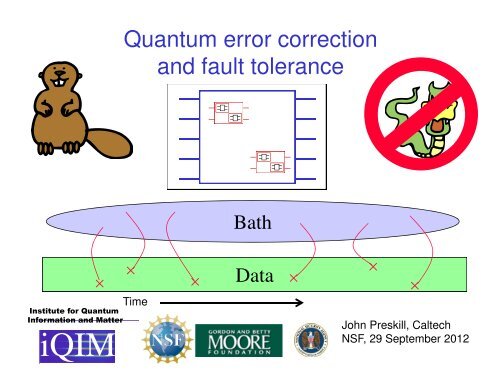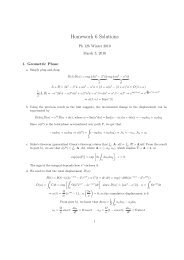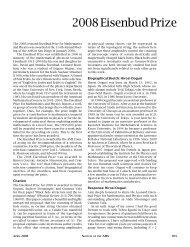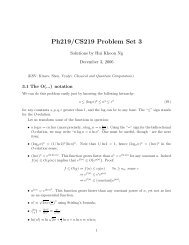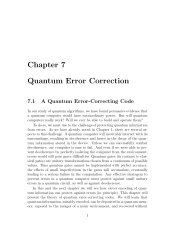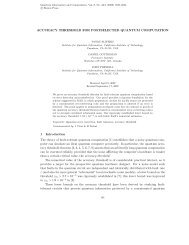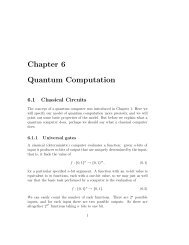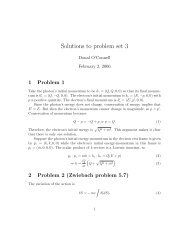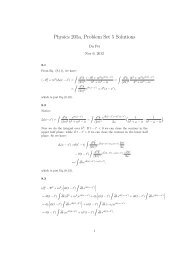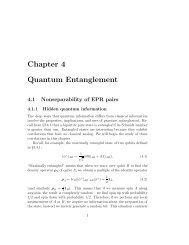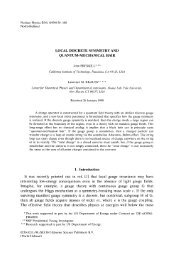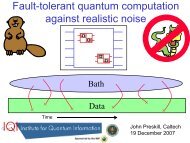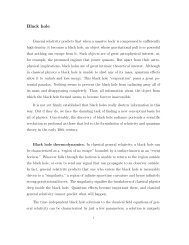Quantum error correction and fault tolerance - Caltech Theoretical ...
Quantum error correction and fault tolerance - Caltech Theoretical ...
Quantum error correction and fault tolerance - Caltech Theoretical ...
Create successful ePaper yourself
Turn your PDF publications into a flip-book with our unique Google optimized e-Paper software.
<strong>Quantum</strong> <strong>error</strong> <strong>correction</strong><br />
<strong>and</strong> <strong>fault</strong> <strong>tolerance</strong><br />
Bath<br />
Institute for <strong>Quantum</strong><br />
Information <strong>and</strong> Matter<br />
iQIM<br />
×<br />
× × Data ×<br />
Time<br />
×<br />
×<br />
John Preskill, <strong>Caltech</strong><br />
NSF, 29 September 2012
Truism:<br />
the macroscopic world is classical.<br />
the microscopic world is quantum.<br />
Goal of QIS:<br />
controllable quantum behavior in scalable systems<br />
Why?<br />
Classical systems cannot simulate quantum<br />
systems efficiently (a widely believed but unproven<br />
conjecture).<br />
But to control quantum systems we must slay the<br />
dragon of decoherence …<br />
Is this merely really, really hard?<br />
Or is it ridiculously hard?
Why quantum computing is hard<br />
We want qubits to interact strongly<br />
with one another.<br />
We don’t want qubits to interact with<br />
the environment.<br />
Until we measure them.
Schoelkopf<br />
Martinis<br />
Yacoby<br />
<strong>Quantum</strong> Hardware<br />
Two-level ions in a Paul trap, coupled to “phonons.”<br />
Superconducting circuits with Josephson junctions.<br />
Electron spin (or charge) in quantum dots.<br />
Cold neutral atoms in optical lattices.<br />
Two-level atoms in a high-finesse microcavity, strongly<br />
coupled to cavity modes of the electromagnetic field.<br />
Linear optics with efficient single-photon sources <strong>and</strong><br />
detectors.<br />
Nuclear spins in semiconductors, <strong>and</strong> in liquid state<br />
NMR.<br />
Nitrogen vacancy centers in diamond.<br />
Anyons in fractional quantum Hall systems, quantum<br />
wires, etc.<br />
Winel<strong>and</strong><br />
Blatt<br />
Marcus
<strong>Quantum</strong> computer: the st<strong>and</strong>ard model<br />
(1) Hilbert space of n qubits:<br />
(2) prepare initial state:<br />
| 0 〉 = | 000…<br />
0〉<br />
(3) execute circuit built from set of<br />
universal quantum gates: U , U , U ,…<br />
U<br />
1 2 3 n G<br />
(4) measure in basis { | 0 〉,|1〉}<br />
⊗n<br />
H =<br />
C<br />
{ }<br />
The model can be simulated by a classical computer with access to a<br />
r<strong>and</strong>om number generator. But there is an exponential slowdown, since the<br />
simulation involves matrices of exponential size… Thus we believe that<br />
quantum model is intrinsically more powerful than the corresponding<br />
classical model.<br />
The goal of <strong>fault</strong>-tolerant quantum computing is to simulate accurately the<br />
ideal quantum circuit model using the imperfect noisy gates that can be<br />
executed by an actual device (assuming the noise is not too strong).<br />
2 n
The goal of <strong>fault</strong>-tolerant quantum computing is to operate a<br />
large-scale (quantum) computer reliably, even though the<br />
components of the computer are noisy.<br />
Reliability can be enhanced by encoding the computer’s state in<br />
the blocks of a quantum <strong>error</strong>-correcting code. Each “logical”<br />
qubit is stored nonlocally, shared by many physical qubits,<br />
<strong>and</strong> can be protected if the noise is sufficiently weak <strong>and</strong> also<br />
sufficiently weakly correlated in space <strong>and</strong> time.<br />
Two central questions are:<br />
<strong>Quantum</strong> <strong>fault</strong> <strong>tolerance</strong><br />
1) For what noise models does <strong>fault</strong>-tolerant quantum computing<br />
work effectively?<br />
2) For a given noise model, what is the overhead cost of<br />
simulating an ideal quantum computation with noisy<br />
hardware?
<strong>Quantum</strong> <strong>fault</strong> <strong>tolerance</strong><br />
To really operate a large-scale quantum computer, many<br />
implementation-specific systems engineering issues will<br />
need to be addressed.<br />
Though I am a theoretical physicist, not an engineer, I have<br />
devoted much of my research effort since the mid-1990s to<br />
quantum <strong>fault</strong> <strong>tolerance</strong>, because I believe that this subject<br />
raises questions <strong>and</strong> stimulates insights that are of broad<br />
<strong>and</strong> fundamental interest in quantum information science.<br />
Whatever the applications turn out to be, the quest for a largescale<br />
quantum computer is one of the gr<strong>and</strong> scientific<br />
challenges of the 21 st century.
<strong>Quantum</strong> <strong>error</strong> <strong>correction</strong><br />
Protect not just against bit flips, but also against the<br />
environment “watching the computer,” so that<br />
computational paths can interfere.<br />
If a quantum computation works, <strong>and</strong> you ask the<br />
quantum computer later what it did, it should answer: “I<br />
forget..”<br />
The computation is encrypted, i.e. hidden from the<br />
environment. (Not the answer, which is classical, but the<br />
path followed by the computer to reach the answer.)<br />
And even a properly “encrypted” computation may fail,<br />
unless the gates are sufficiently accurate.<br />
Irony: Macroscopic systems are usually highly vulnerable<br />
to decoherence, but we can protect information better by<br />
encoding it nonlocally, in a “macroscopic” memory.
<strong>Quantum</strong> <strong>error</strong> <strong>correction</strong> (<strong>and</strong> topological order)<br />
A “logical qubit” is encoded using many “physical qubits.” We want to<br />
protect the logical qubit, with orthonomal basis states |0Ú <strong>and</strong> |1Ú, from<br />
a set of possible <strong>error</strong> operators { E a }.<br />
For protection against bit flips:<br />
E a |0Ú ^ E b |1Ú .<br />
For protection against phase <strong>error</strong>s:<br />
E a (|0Ú + |1Ú) ^ E b (|0Ú - |1Ú) .<br />
In fact, these conditions suffice to ensure the existence of a recovery<br />
map.<br />
It follows that<br />
‚0| E b æE a |0Ú = ‚1| E b æE a |1Ú .<br />
Compare the definition of topological order: if V is a (quasi-)local<br />
operator <strong>and</strong> |0Ú, |1Ú are ground states of a local Hamiltonian, then<br />
‚1| V |0Ú = 0, <strong>and</strong> ‚0| V |0Ú = ‚1| V |1Ú .<br />
up to <strong>correction</strong>s exponentially small in the system size. (Ground<br />
states are locally indistinguishable.)
Scalable quantum computing<br />
<strong>Quantum</strong> Accuracy Threshold Theorem: Consider a quantum computer<br />
subject to quasi-independent noise with strength ε . There exists a constant<br />
ε 0 >0 such that for a fixed ε < ε 0 <strong>and</strong> fixed δ > 0, any circuit of size L can be<br />
simulated by a circuit of size L* with accuracy greater than 1-δ, where, for<br />
some constant c,<br />
assuming:<br />
( )<br />
L* = O ⎡L log L ⎤ ⎣ ⎦<br />
parallelism, fresh qubits (necessary assumptions)<br />
nonlocal gates, fast measurements, fast <strong>and</strong> accurate classical<br />
processing, no leakage (convenient assumptions).<br />
“Practical” considerations:<br />
Resource requirements, systems engineering issues<br />
Matters of “principle”:<br />
Conditions on the noise model, what schemes are scalable, etc.<br />
c<br />
Aharonov, Ben-Or<br />
Kitaev<br />
Laflamme, Knill, Zurek<br />
Aliferis, Gottesman, Preskill<br />
Reichardt
Accuracy Threshold<br />
Accuracy threshold theorems have been proved<br />
for three types of <strong>fault</strong>-tolerant schemes:<br />
Recursive: hierarchy of gadgets within<br />
gadgets, with logical <strong>error</strong> rate decreasing<br />
rapidly with level.<br />
Topological: check operators are local on a twodimensional<br />
surface, <strong>and</strong> detect the boundary<br />
points of <strong>error</strong> chains. Logical <strong>error</strong> rate decays<br />
exponentially with block’s linear size.<br />
Teleported: Encoded Bell pairs are<br />
prepared recursively, but used only at<br />
the top level. The (quantum) depth<br />
blowup of the simulation is a constant<br />
factor.
Noise models<br />
Two types of noise models are most commonly considered in rigorous<br />
estimates of the accuracy threshold.<br />
time<br />
space<br />
In the local stochastic noise model,<br />
“<strong>fault</strong> paths” are assigned probabilities. × ×<br />
×<br />
For any set of r gates in the circuit, the computation<br />
probability that all r of the gates have<br />
×<br />
×<br />
×<br />
<strong>fault</strong>s is no larger than ε r .<br />
The threshold theorem shows that <strong>fault</strong>-<strong>tolerance</strong> works for ε < ε 0 . Though<br />
not fully realistic, these models provide a useful caricature of noise in actual<br />
devices, <strong>and</strong> can be compared with simulations.<br />
In more realistic Hamiltonian noise models, <strong>fault</strong> paths can add coherently.<br />
The joint dynamics of the system <strong>and</strong> “bath” is determined by a Hamiltonian<br />
Bath<br />
×<br />
× × Data × ×<br />
×<br />
time<br />
H = H + H + H<br />
−<br />
System Bath System Bath<br />
that acts locally on the system. Fault<br />
<strong>tolerance</strong> works if the system-bath<br />
coupling responsible for the noise is<br />
sufficiently weak.
Non-Markovian noise<br />
Terhal, Burkard 2005; Aliferis, Gottesman, Preskill 2006;<br />
Aharonov, Kitaev, Preskill 2006; Ng, Preskill 2009<br />
From a physics perspective, it is natural to formulate the noise model in<br />
terms of a Hamiltonian that couples the system to the environment.<br />
H = H + H + H<br />
−<br />
where<br />
System Bath System Bath<br />
( a)<br />
H<br />
System Bath<br />
H<br />
−<br />
terms a acting<br />
locally on the system<br />
−<br />
= ∑<br />
System Bath<br />
Threshold condition can be formulated as ε ≤ ε 0 @ 10 -4 , where noise<br />
strength ε can be defined in either of two ways:<br />
ε =<br />
max<br />
over all times<br />
<strong>and</strong> locations<br />
H<br />
( a)<br />
System−Bath<br />
Internal bath dynamics can<br />
be strong <strong>and</strong> nonlocal<br />
t<br />
0<br />
gate execution time<br />
Bath<br />
×<br />
× Data ×<br />
×<br />
×<br />
×<br />
Time<br />
⎛<br />
⎜<br />
ε = max ∫ ∫ ∆Bath<br />
(1,2)<br />
⎜ 1, circuit 2, all<br />
⎝ location spacetime<br />
bath correlation function<br />
applies for a Gaussian<br />
(harmonic oscillator) bath<br />
In either scenario, noise Hamiltonian is assumed to act locally on the system<br />
⎞<br />
⎟<br />
⎟<br />
⎠<br />
1/2
Accuracy Threshold<br />
Some threshold estimates for stochastic<br />
noise:<br />
Recursive: ε 0 > 1.94 ä 10 −4 proven for local<br />
stochastic noise using “Bacon-Shor codes.<br />
-- Aliferis, Cross<br />
Topological: ε 0 ∼ 7.5 ä 10 −3 estimated for<br />
independent depolarizing noise in a local twodimensional<br />
measurement-based scheme<br />
(combination of numerics <strong>and</strong> analytic argument).<br />
-- Raussendorf, Harrington, Goyal<br />
Teleported: ε 0 > 6.7 ä 10 −4 proven for local<br />
stochastic noise using concatenated <strong>error</strong>detecting<br />
codes (ε 0 > 1.25 ä 10 −3 for<br />
depolarizing noise); simulations indicate<br />
ε 0 ∼ 1 ä 10 −2 for depolarizing noise.<br />
-- Knill; Aliferis, Preskill
Limitations on transversal<br />
(local unitary) logical gates<br />
The logical gates close to the identity that can be executed<br />
with local unitary transformations form a (perhaps trivial) Lie<br />
algebra.<br />
U = I + ε ( + A + ⋯+<br />
)<br />
A1 2<br />
A n<br />
If the code can “detect” a weight-one<br />
<strong>error</strong>, then for each i:<br />
Π Ai<br />
Π ∝ Π<br />
( Π= projector onto code space)<br />
If U preserves the code space,<br />
then U acts trivially on code space: U Π = Π U Π = Π<br />
There are no transversal gates close to the identity. The group<br />
generated by transversal gates is finite <strong>and</strong> hence<br />
nonuniversal. Which logical gates can be executed<br />
transversally depends on what code we use.<br />
Eastin-Knill 2009
Limitations on constant-depth logical gates<br />
in topological stabilizer codes<br />
Topological stabilizer code: check operators are geometrically<br />
local Pauli operators; code distance is “macroscopic.”<br />
What logical gates can be executed using constant depth<br />
circuits of geometrically local gates, which are inherently <strong>fault</strong>tolerant<br />
(each <strong>fault</strong> affects O(1) qubits).<br />
2 (<br />
−1<br />
D : U Pauli) U ∈ Pauli,<br />
U ∈C2<br />
3 D : U ( Pauli)<br />
U<br />
etc.<br />
−1<br />
∈C<br />
,<br />
U<br />
∈C<br />
2 3<br />
Applies to only a special class of quantum codes, but to a<br />
broader class of protected gates than transversal gates.<br />
(Clifford)<br />
Bravyi-Koenig 2012
Transversal gates are topological<br />
Under local unitaries, an initial K-dimensional quantum code gets mapped<br />
to a new K-dimensional code. The family of LU-equivalent codes is a<br />
manifold, the base space of a fiber bundle with a U(K) structure group. (LU<br />
defines a notion of parallel transport of the code space.)<br />
A transversal gate corresponds to a loop in the base space, where we<br />
return to the original code, but with a nontrivial “twist.”<br />
But small loops define trivial gates (no transversal logical gates close to the<br />
identity). Hence the connection is flat.<br />
A transversal gate is executed<br />
by traversing a noncontractible<br />
path on the manifold of LUequivalent<br />
codes.<br />
Gottesman & Zhang 2012.
Gate teleportation <strong>and</strong> state distillation<br />
In <strong>fault</strong>-tolerant schemes, a version of<br />
quantum teleportation is used to<br />
complete a universal set of protected<br />
quantum gates. Suitable “quantum<br />
software” is prepared <strong>and</strong> verified<br />
offline, then measurements are<br />
performed that transform the incoming<br />
data to outgoing data, with a “twist” (an<br />
encoded operation) determined by the<br />
software.<br />
noisy in<br />
noisy in<br />
distillation<br />
protocol<br />
discard<br />
less noisy out<br />
(if accepted)<br />
data in<br />
purified<br />
“quantum<br />
software”<br />
Bell<br />
meas.<br />
(<strong>and</strong><br />
EC)<br />
data out<br />
Reliable software is obtained from<br />
noisy software via a multi-round state<br />
distillation protocol. In each round<br />
(which uses CNOT gates <strong>and</strong><br />
measurements), there are n noisy<br />
input copies of the software of which<br />
n-k copies are destroyed. The<br />
remaining output k copies, if accepted,<br />
are less noisy than the input copies<br />
Gottesman, Chuang; Knill; Bravyi, Kitaev
Beyond transversal gates?<br />
For gates needed to complete a universal set, we need to go outside the<br />
manifold of LU-equivalent codes.<br />
We embed the manifold in a larger<br />
manifold, <strong>and</strong> traverse a noncontractible<br />
path in the larger manifold.<br />
We should be able to underst<strong>and</strong> ancilla<br />
constructions including magic state<br />
distillation in this framework.<br />
In general, our gate set includes gates that<br />
are constructed by temporarily leaving the<br />
manifold of LU-equivalent codes, <strong>and</strong> then<br />
returning to it eventually.<br />
Gottesman & Zhang 2012.
Self-Correcting <strong>Quantum</strong> Memory?<br />
Example: 1D ferromagnet (repetition code)<br />
0 0 0 0 1 1 1 1 0 0 0<br />
When a connected (one-dimensional) droplet of<br />
flipped spins arises due to a thermal fluctuation,<br />
only the (zero-dimensional) boundary of the droplet<br />
contributes to the energy; thus the energy cost is<br />
independent of the size of the droplet.<br />
Therefore, thermal fluctuations disorder the spins at<br />
any nonzero termperature. A one-dimensional<br />
ferromagnet is not a robust (classical) memory.
2D ferromagnet (repetition code)<br />
This memory is a repetition code, but<br />
with redundant (hence robust) parity<br />
checks.<br />
Again, droplets of flipped<br />
spins arise as thermal fluctuations. But<br />
now the energy cost of a (twodimensional)<br />
droplet is proportional to<br />
the length of its (one-dimensional)<br />
boundary.<br />
Therefore, droplets with linear size L are<br />
suppressed at sufficiently low nonzero<br />
temperature T by the Boltzmann factor<br />
exp(-L / T), <strong>and</strong> are rare.<br />
The storage time for classical information becomes exponentially long<br />
when the block size is large. (Actual storage media, which are robust at<br />
room temperature, rely on this physical principle.)
Topological Code<br />
A topological medium in 2D is similar to<br />
the 1D Ising model: pairs of anyons are<br />
produced by thermal fluctuations at a rate<br />
that does not depend on the system size.<br />
These anyons can then diffuse apart<br />
without any additional energy cost. When<br />
anyons diffuse a distance comparable to<br />
the distance between pairs, logical <strong>error</strong>s<br />
arise.<br />
Therefore, thermal fluctuations disorder<br />
the system at any nonzero termperature.<br />
A two-dimensional topological medium is<br />
not self-correcting quantum memory.
Topological order at finite temperature<br />
In the 4D toric code, the energy cost of a 2D droplet of<br />
flipped qubits is proportional to the length of its 1D<br />
boundary.<br />
To cause encoded <strong>error</strong>s, Droplets of linear size L, which<br />
could cause encoded <strong>error</strong>s, are suppressed at sufficiently<br />
low nonzero temperature T by the Boltzman factor<br />
exp(-L / T), <strong>and</strong> are rare (Dennis et al. 2002).<br />
L<br />
Question: Is “finite-temperature topological order” possible in less than 4D?<br />
In the 3D toric code, we can choose to have point defects at the boundary<br />
of 1D bit-flip <strong>error</strong> chains <strong>and</strong> string defects at the boundary of 2D phase<strong>error</strong><br />
droplets, or the other way around.<br />
The 3D toric code is a self-correcting classical memory, which unlike the 2D<br />
Ising model, is stable with respect to an applied “magnetic field.”<br />
But the 3D toric code is not a self-correcting quantum memory.
Self-<strong>correction</strong> in two dimensions?<br />
Local commuting projector code:<br />
The code is the simultaneous eigenspace of a set of<br />
commuting projectors. Again, there is a “string logical<br />
operator,” only “slightly entangling” across a cut through the<br />
string. (Haah-Preskill, Bravyi-Poulin-Terhal, Bravyi-Terhal).<br />
Logical <strong>error</strong> due<br />
to particle sliding<br />
along strip?<br />
Build the string operator:<br />
Divide the strip into constant-length segments.<br />
Each time we wish to extend the string, “twirl” the<br />
next segment <strong>and</strong> project. If we fail, twirl <strong>and</strong> try<br />
again.<br />
If the code satisfies the “local topological order” condition (proposed to<br />
ensure stability with respect to generical perturbations), then the projection<br />
succeeds with constant probability (no “blind alleys”).<br />
L<strong>and</strong>on-Cardinal & Poulin 2012
Excitations in local classical <strong>and</strong> quantum codes<br />
Mobile pointlike excitations:<br />
1D Ising model, 2D toric code<br />
No pointlike excitations:<br />
2D Ising model, 4D toric code<br />
Immobile pointlike excitations:<br />
3D Haah code (2011).<br />
There are mobile point defects in any<br />
“scale-invariant” translation-invariant 3D<br />
stabilizer code (Yoshida 2011).
Haah’s code Haah 2011<br />
A local stabilizer code with two qubits per site on a simple cubic lattice.<br />
Two stabilizer generators on each cube.<br />
No logical string operators.<br />
Code distance grows faster than linearly with linear system size L.<br />
The barrier height for a logical <strong>error</strong> is O( log L).<br />
Topologically ordered: code states look the same locally.<br />
Equilibrates slowly when cooled from high to low temperature (glass).<br />
For weak noise, annealing corrects <strong>error</strong>s with high success probability.
Degeneracy on L µ L µ L torus
Isolated charges<br />
A local process starting from the “vacuum” (no excitations) <strong>and</strong><br />
arriving at a state where a single topological defect is isolated from<br />
all others by distance at least R, must pass through a state whose<br />
“energy” is logarithmic in R.<br />
This energy barrier impedes thermal defect diffusion, enhancing<br />
the stability of the quantum memory.
Memory time<br />
Bravyi-Haah 2011<br />
But once the system size grows beyond an<br />
optimal size, the entropy of the defects grows<br />
exponentially with volume, overwhelming the<br />
logarithmic energy cost. Thus the memory time<br />
is a constant depending on the temperature.<br />
Because of the logarithmically<br />
increasing height of the logical<br />
energy barrier, the memory time<br />
grows like a power of volume<br />
for small system size.<br />
Ω( β )<br />
t ~ V mem<br />
(<br />
−1<br />
β = (temperature) )<br />
V<br />
t<br />
* Ω( β )<br />
~<br />
e<br />
*<br />
~ e<br />
Ω( β )<br />
mem<br />
Michnicki 2012: Energy barrier O(L 2/3 ) in 3D code w/o translation invariance.<br />
2
Nonabelian anyons<br />
<strong>Quantum</strong> information can be stored in the collective state<br />
of exotic particles in two spatial dimensions (“anyons”).<br />
The information can be processed by exchanging the<br />
positions of the anyons (even though the anyons never<br />
come close to one another).
Topological quantum computation (Kitaev ’97, FLW ‘00)<br />
annihilate pairs?<br />
braid<br />
braid<br />
Kitaev<br />
braid<br />
time<br />
create pairs<br />
Freedman
Topological quantum computation<br />
time<br />
The computation is<br />
intrinsically resistant<br />
to decoherence.<br />
If the paths followed<br />
by the particles in<br />
spacetime execute<br />
the right braid, then<br />
the quantum<br />
computation is<br />
guaranteed to give<br />
the right answer!
Anyons: the fractional quantum Hall effect<br />
high magnetic field<br />
electrons moving freely<br />
on a “table,” at very low<br />
temperature<br />
An exotic new phase of matter, with particle excitations that are profoundly<br />
different than electrons.<br />
These particles are anyons: they have<br />
topological interactions.
Majorana fermions at the ends of quantum wires<br />
(Kitaev 2001)<br />
Topological superconductor:<br />
charge can be odd multiple of e.<br />
Alicea et al.:<br />
To exchange<br />
particles, park<br />
one using a<br />
T-junction.<br />
Anyons, appearing where topological<br />
<strong>and</strong> normal superconductors meet,<br />
move as chemical potential is adjusted.<br />
(The topologically<br />
protected gates<br />
are not universal.)
Hardware<br />
Software<br />
-- Robust devices (e.g. “0-Pi”<br />
superconducting qubit).<br />
-- Topological protection <strong>and</strong><br />
processing (e.g. Majorana fermions<br />
in quantum wires).<br />
-- Optimized threshold <strong>and</strong> overhead.<br />
-- Adapting <strong>fault</strong> <strong>tolerance</strong> to noise.<br />
-- Dynamical decoupling.<br />
Systems engineering (wires, power, cooling, etc.)<br />
-- Limitations on noise correlations<br />
Matters of principle<br />
-- Justifying <strong>error</strong> phase r<strong>and</strong>omization → <strong>error</strong> probabilities (e.g., relating<br />
<strong>error</strong> benchmarking to <strong>fault</strong> <strong>tolerance</strong> requirements).<br />
-- Self-correcting hardware (e.g., favorable scaling of storage time with<br />
system size, in fewer than four dimensions?).<br />
-- Other scalable schemes besides concatenated codes <strong>and</strong> topological<br />
codes (perhaps <strong>fault</strong>-tolerant adiabatic quantum computing?).<br />
-- Broader implications of quantum <strong>error</strong> <strong>correction</strong> in physical science.
<strong>Quantum</strong> <strong>fault</strong> <strong>tolerance</strong><br />
Operating a large-scale quantum computer will be a gr<strong>and</strong><br />
scientific <strong>and</strong> engineering achievement.<br />
Judicious application of the principles of <strong>fault</strong>-tolerant quantum<br />
computing will be the key to making it happen.<br />
Fascinating connections with statistical physics, quantum manybody<br />
theory, device physics, <strong>and</strong> decoherence make the<br />
study of quantum <strong>fault</strong> <strong>tolerance</strong> highly rewarding.
Additional<br />
Slides
Noise correlations <strong>and</strong> scalability<br />
In general, the noise Hamiltonian may contain terms acting on m system<br />
qubits, for m = 1, 2, 3, ….<br />
∑ ∑ ∑ ⋯<br />
H = H + H + H +<br />
(1) (2) (3)<br />
System−Bath i ij ijk<br />
i 〈 ij〉 〈 ijk 〉<br />
<strong>Quantum</strong> computing is provably scalable if ε ≤ ε 0 @ 10 -4 , where<br />
η<br />
ε = (9.44) × max η <strong>and</strong><br />
2 3<br />
m<br />
1/ m<br />
m<br />
= max ∑ ‖ H ‖ t<br />
( m)<br />
m j1 j1 j2 j3…<br />
j<br />
j , j ,…,<br />
j<br />
m<br />
m<br />
0<br />
[ t 0 is the maximal duration<br />
of any quantum gate. ]<br />
over all times<br />
<strong>and</strong> qubits<br />
interactions fall<br />
off with distance<br />
term that acts collectively on m system<br />
qubits should be exponentially small in m.<br />
Currently known proofs of the threshold theorem require the noise to be<br />
“quasi-local” in the sense that the m-qubit noise term in the Hamiltonian<br />
decays exponentially with m. Can experiments verify this scaling?<br />
Preskill 2012
Self-<strong>correction</strong> in two dimensions?<br />
Consider a stabilizer (or subsystem) code.<br />
Cleaning Lemma: If a set of qubits M is correctable<br />
(supports no nontrivial logical operator), then any nontrivial<br />
logical Pauli operator can be “cleaned” by applying<br />
stabilizer generators, so it acts trivially on M.<br />
Theorem (Bravyi-Terhal 2009, Kay-Colbeck 2008): A 2D stabilizer code has<br />
a “string logical operator.”<br />
Cover the code block with stripes or alternating color, wide<br />
enough so that no check operator acts on two stripes of the<br />
same color. If the gray stripes are correctable, they can be<br />
cleaned, so there is a nontrivial logical operator supported<br />
on blue stripes.<br />
Each check operator overlaps with just one blue stripe,<br />
so the operator on each blue stripe is logical, <strong>and</strong> for at<br />
least one stripe is nontrivial.
Protected superconducting qubit<br />
Ioffe et al.<br />
Kitaev<br />
One way to make a robust superconducting (0-Pi) qubit is to build a long chain of<br />
devices. Each individual device favors a phase change of 0 or p across its leads.<br />
The phase difference between the two ends of the chain can likewise be either 0 or<br />
p but with large local phase fluctuations along the chain.<br />
0 q = 0 ….<br />
q<br />
The two basis states of the qubit are distinguished by a global property of the chain<br />
--- both look the same locally. For long chain, the breaking of the degeneracy of the<br />
two states due to a generic local perturbation occurs in a high order of perturbation<br />
theory <strong>and</strong> is strongly suppressed.<br />
The barrier is high enough to suppress bit flips,<br />
<strong>and</strong> the stable degeneracy suppresses phase<br />
<strong>error</strong>s. Protection arises because the encoding<br />
of quantum information is highly nonlocal, <strong>and</strong><br />
splitting of degeneracy scales exponentially<br />
with (square root of) size of the device.<br />
( ( ))<br />
E ≈ f (2 θ ) + O exp −c<br />
size
Protected superconducting qubit<br />
Some gates are also protected: we can execute<br />
⎛ π ⎞ ⎛ π ⎞<br />
exp ⎜i Z ⎟ <strong>and</strong> exp⎜i Z1 ⊗ Z2<br />
⎟<br />
⎝ 4 ⎠ ⎝ 4 ⎠<br />
Kitaev,<br />
Brooks,<br />
Preskill<br />
with exponential precision. This is achieved by coupling a qubit or a pair of<br />
qubits to a “superinductor” with large phase fluctuations:<br />
qubit<br />
two<br />
qubits<br />
L / C ≫1<br />
To execute the gate, we (1) close the switch, (2) keep it closed for awhile, (3) open<br />
the switch. This procedure alters the relative phase of the two basis states of the<br />
qubit:<br />
− i<br />
α<br />
π / 2<br />
( a b ) ( a be α<br />
)<br />
0 + 1 ⊗ init → 0 + 1 ⊗ final<br />
time switch<br />
Is closed<br />
The relative phase induced by the gate<br />
“locks” at π/2. For L / C ≈ 80<br />
phase <strong>error</strong> ~ few X 10 -8 is achieved for<br />
timing <strong>error</strong> of order 1 percent. Why?
Protected phase gate<br />
⎛ π ⎞<br />
exp⎜i<br />
Z ⎟<br />
⎝ 4 ⎠<br />
Switch is really a tunable Josephson junction:<br />
H<br />
j<br />
q<br />
C L<br />
0<br />
2 2<br />
Q ϕ<br />
= + − J ( t)cos<br />
ϕ −θ<br />
2C<br />
2L<br />
V(ϕ)<br />
qubit<br />
( )<br />
Kitaev,<br />
Brooks,<br />
Preskill<br />
2<br />
L / C ≫ ħ / (2 e) ≈1k<br />
Ω<br />
Under suitable adiabaticity<br />
conditions, closing the switch<br />
transforms a broad oscillator<br />
state (e.g. the ground state)<br />
into a grid state (approximate<br />
codeword).<br />
Gottesman,<br />
Kitaev,<br />
Preskill<br />
Peaks are at even or odd multiples of π depending on whether θ is 0 or π, i.e. on<br />
whether qubit is 0 or 1. Inner width squared is (JC) -1/2 <strong>and</strong> outer width is (L/C) 1/2<br />
ω<br />
−1 −1<br />
J<br />
= C J ω = LC<br />
ϕ<br />
∆<br />
κ<br />
−1<br />
/ ≪ switching time ≪ ≫ 1<br />
ϕ
( L / C)<br />
( JC )<br />
τ<br />
J<br />
1/2<br />
1/2<br />
/ C =<br />
=<br />
= 8<br />
80<br />
80<br />
P<br />
ε<br />
| +〉 C<br />
( ) <strong>error</strong><br />
calculable contribution to<br />
<strong>error</strong> due to diabatic effects<br />
<strong>and</strong> Q-space spreading
Some recently reported <strong>error</strong> rates<br />
Ion trap – one-qubit gates:<br />
~ 2 ä 10 -5 [NIST]<br />
Winel<strong>and</strong><br />
Ion trap – two-qubit gates:<br />
~ 5 ä 10 -3 [Innsbruck]<br />
Superconducting circuits – one-qubit gate<br />
~ 2.5 ä 10 -3 [Yale]<br />
Blatt<br />
Error rates are estimated by performing “circuits”<br />
of variable size, <strong>and</strong> observing how the <strong>error</strong> in the<br />
final readout grows with circuit size.<br />
Schoelkopf
Asymmetric Bacon-Shor codes<br />
• Goal: design circuits for<br />
<strong>fault</strong>-tolerant quantum<br />
computation that take<br />
advantage of dephasing bias<br />
in noise<br />
• Encode within n x m block<br />
of Bacon-Shor code<br />
• Independently tunable levels<br />
of X <strong>and</strong> Z <strong>error</strong> protection<br />
• Gauge structure allows<br />
measuring high-weight<br />
stabilizers with weight 2<br />
gauge operators<br />
Stabilizers<br />
Z Z X X Z<br />
Z Z X X Z<br />
X X<br />
Gauge operators<br />
X X<br />
Z<br />
Z
Asymmetric Bacon-Shor codes<br />
Block 1 Block 2<br />
Data qubit<br />
Ancilla qubit<br />
Potential CZ location<br />
Bacon-Shor gauge structure permits a<br />
geometrically local architecture with gates<br />
only acting on nearest neighbors<br />
...
Asymmetric Bacon-Shor codes<br />
• When bias is high, can achieve a low <strong>error</strong> rate with significantly reduced overhead compared to<br />
the unbiased case
Asymmetric Bacon-Shor codes<br />
• To achieve universality, use magic state injection <strong>and</strong> distillation protocols<br />
• Analyze distilled state output <strong>error</strong> probability while explicitly accounting for imperfect Clifford<br />
gates<br />
• Starting with input <strong>error</strong> probability of 0.01, 2-3 rounds of distillation suffice to reach maximum<br />
amount of distillation for essentially all practical encoded Clifford <strong>error</strong> rates
How fast does information escape from a black hole?<br />
Hayden,<br />
Preskill<br />
Alice<br />
black hole<br />
Bob<br />
Black holes are (we believe) efficient<br />
quantum information processors.<br />
How long do we have to wait for<br />
information absorbed by a black hole<br />
to be revealed in its emitted Hawking<br />
radiation? We reconsidered this<br />
question using tools from quantum<br />
information theory.<br />
Bob decodes<br />
radiation<br />
maximal<br />
entanglement<br />
strongly<br />
mixing<br />
unitary<br />
black<br />
hole<br />
black<br />
hole<br />
Alice’s<br />
qubits<br />
Our (tentative) conclusion is that the retention time can be surprisingly short.<br />
The analysis uses the theory of quantum <strong>error</strong>-correcting codes <strong>and</strong> quantum<br />
circuits.


